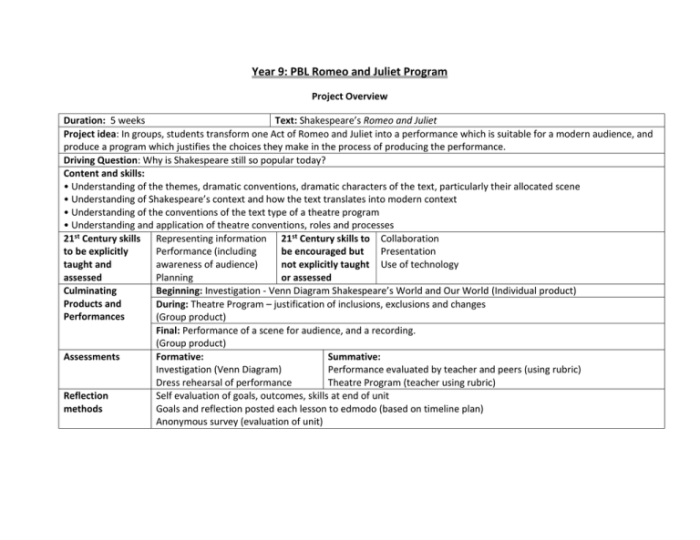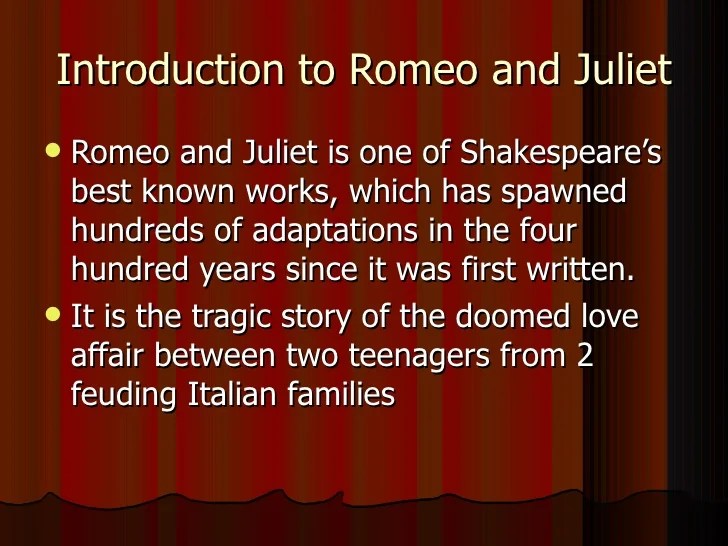Embarking on the romeo and juliet unit introduction, this journey immerses readers in a timeless and captivating narrative, with engaging insights and thought-provoking perspectives that unravel the intricacies of Shakespeare’s masterpiece from the very first sentence.
Delving into the heart of this iconic play, we will explore the significance of Romeo and Juliet as a literary classic, tracing its historical and cultural roots. We will delve into the depths of its characters, examining their motivations, relationships, and the tragic consequences that befall them.
Overview of Romeo and Juliet: Romeo And Juliet Unit Introduction

Romeo and Juliet is a timeless literary masterpiece by William Shakespeare that explores the complexities of love, fate, and conflict. Set in 16th-century Verona, Italy, the play follows the star-crossed lovers Romeo Montague and Juliet Capulet, whose forbidden romance leads to tragic consequences.
The play’s historical and cultural context is crucial for understanding its themes and characters. Written during the English Renaissance, Romeo and Juliet reflects the social and political turmoil of the time, including the rise of humanism and the conflict between old and new values.
Characters and Relationships
Romeo Montague is a young, idealistic, and passionate nobleman who falls deeply in love with Juliet. Juliet Capulet is a beautiful, intelligent, and headstrong young woman who is torn between her family’s wishes and her own heart.
The relationship between Romeo and Juliet is the central focus of the play. Their love is intense, passionate, and ultimately doomed. They face numerous obstacles, including their feuding families, the law, and their own youthful impulsiveness.
Supporting characters, such as Mercutio and Friar Laurence, play significant roles in the play. Mercutio is Romeo’s loyal friend and confidant, while Friar Laurence attempts to help the lovers but ultimately contributes to their downfall.
Themes and Motifs
Romeo and Juliet explores several central themes, including:
- Love: The play celebrates the power and intensity of love, but also its potential for destruction.
- Fate: The characters are constantly confronted with the idea of fate and the inevitability of their tragic end.
- Conflict: The play is driven by the conflict between the Montagues and Capulets, as well as the internal conflict within the characters themselves.
Shakespeare uses several motifs to convey meaning in Romeo and Juliet, including:
- Light and darkness: Light is associated with hope and love, while darkness is associated with despair and death.
- Poison: Poison is a recurring symbol of the play’s tragic events, representing both physical and emotional harm.
Language and Style, Romeo and juliet unit introduction
Shakespeare’s use of language in Romeo and Juliet is masterful. He employs a rich vocabulary, vivid imagery, and complex metaphors to create a poetic and evocative world.
The play is written in iambic pentameter, a poetic rhythm that contributes to its musicality and emotional impact. Shakespeare also uses sonnets, a type of fourteen-line poem, to express the characters’ innermost thoughts and feelings.
The language of Romeo and Juliet enhances the play’s themes and characters, making it a timeless masterpiece of English literature.
Adaptations and Interpretations
Romeo and Juliet has been adapted numerous times over the centuries, including stage productions, films, and musicals.
Different adaptations have interpreted the play’s themes and characters in different ways. Some adaptations focus on the romantic aspect of the story, while others emphasize its tragic elements.
The impact of these adaptations has been significant, as they have helped to keep Romeo and Juliet relevant to new generations of audiences.
FAQ Explained
What is the significance of Romeo and Juliet as a literary classic?
Romeo and Juliet is widely regarded as one of the greatest love stories ever written, capturing the essence of young love, passion, and tragedy. Its enduring themes and characters have resonated with readers and audiences for centuries, making it a timeless masterpiece of literature.
What are the central themes explored in Romeo and Juliet?
The play explores universal themes such as love, fate, and conflict. It delves into the power of love to transcend societal boundaries, the inevitability of fate, and the destructive nature of conflict, both personal and societal.
How does Shakespeare’s language contribute to the emotional impact of Romeo and Juliet?
Shakespeare’s masterful use of language, including his rich vocabulary, vivid imagery, and poetic structure, heightens the emotional impact of the play. His use of sonnets and blank verse creates a lyrical and evocative atmosphere that enhances the intensity of the characters’ emotions and the tragic events that unfold.
